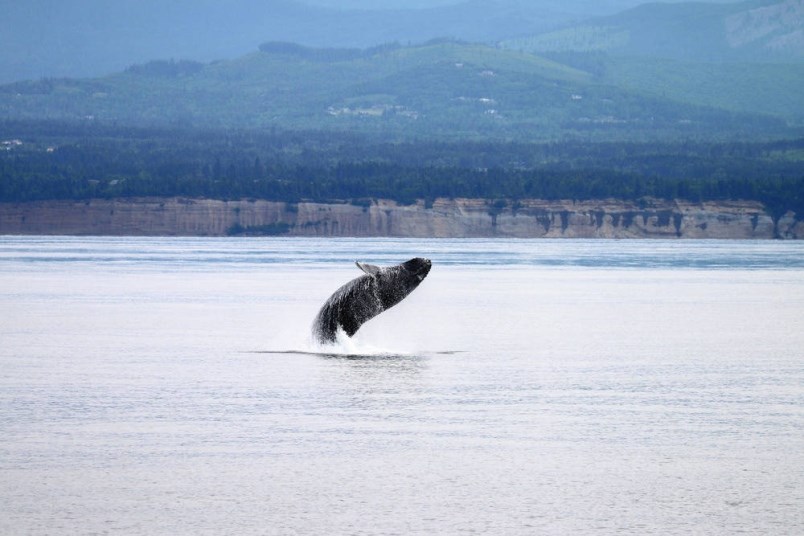Researchers are calling it the “humpback comeback.”
More than century after commercial whaling wiped out humpback whales from inland waters around Â鶹´«Ã½Ó³»Island, the big mammals are showing a significant resurgence.
Since a humpback was first documented in the Salish Sea in 1997 near Race Rocks, just over 500 whales have been recorded feeding and frolicking in the nutrient-rich waters here from April to October.
Their long road back from near extinction has observers optimistic; they say the humpbacks have developed an affinity for the Salish Sea as a key summer location in their migration cycle to bring their young and to feed.
Erin Gless of the Pacific Whale Watch Association said as many as 200 whales will show up this summer — possibly more — and they are coming from different Pacific populations that use birthing grounds off Hawaii, Mexico and Central America.
One of the area’s significant matriarchs, dubbed Big Mama, was spotted in April, and this week three of her calves were sighted all feeding in the same area just off Port Angeles.
Gless said humpback whales are not known to have close family ties, leaving their mothers at less than a year old. The fact that three siblings — born between 2006 and 2016 — were seen in such close proximity to each other has piqued the interest of researchers.
“It could be pure coincidence, or do they know they share a mom? Did she teach them this was a good feeding spot? We don’t really know, but it’s very interesting and something very special,” said Gless.
Big Mama has given birth to six calves that have each returned to the waters around southern Â鶹´«Ã½Ó³»Island, the U.S. San Juan Islands and Washington coast at one time or another, says the Pacific Whale Watch Association.
Whale watchers reported seeing her travelling with her first calf in 2003. Big Mama has since had calves in 2006, 2010, 2012, 2014 and 2016.
When Big Mama arrived in late April, the whale watch community was excited to see her return, as she often marks the beginning of the humpback whale watching season throughout the region.
Her three offspring, identified in the Strait of Juan de Fuca this week, were Split Fin (2006), Tulip (2012), and Pop Tart (2016), her most recent calf named for its playful breaching behaviour.
Researchers document whales by the unique patterns on the undersides of their flukes, or rear fin, which is much like a fingerprint.
“We arrived on scene to find three beautiful humpback whales actively lunge feeding in glass-calm conditions,” said naturalist Samantha Murphy aboard the Island Explorer 5, based in Anacortes, Washington.
“All three humpbacks were within close proximity to one another, but focused on foraging for bait-fish within separate current lines. As we visited each whale and started to gather ID photos, we were shocked and elated to realize that all three whales were siblings.”
Humpbacks were hunted for their blubber which was rendered to oil and the population was decimated in this region. When protective measures were put in place in the 1960s and 1970s, the whales started making a comeback.
The biggest threat now for humpbacks is entanglements in fishing and crabbing lines. The whales often drag floats and anchors for months before succumbing to exhaustion and drowning. This month, marine mammal rescue teams with the Department of Fisheries and Oceans successful freed a tangled humpback off Gabriola Island.
Big Mama was sighted for the first time in 1997 by Mark Malleson, a skipper with Victoria-based Prince of Whales Whale Watching. He didn’t know she was Big Mama at the time, but she was one of the first humpback whales to be spotted in the Strait of Juan de Fuca in nearly 100 years.
“I saw her again in 1999 and then not again until 2003,” Malleson said in a statement to the Pacific Whale Watch Association. “She has not missed a year since then to return to these waters.”
WHERE HUMPBACKS ROAM
At least four humpback whale populations are in the North Pacific:
• The Mexico population, which breeds along the Pacific coast of Mexico and the Revillagigedo Islands, transits the Baja California Peninsula, and feeds across from California to the Aleutian Islands, Alaska.
• The Central America population breeds along the Pacific coast of Central America, including off Costa Rica, Panama, Guatemala, El Salvador, Honduras and Nicaragua, and feeds off the West Coast of the United States and southern British Columbia.
• The Hawaii population, which breeds off the main Hawaiian Islands and feeds in the North Pacific, including the Aleutian Islands/Bering Sea, Gulf of Alaska, Southeast Alaska, and northern British Columbia.
• The Western North Pacific population breeds in areas off Okinawa, Japan, and the Philippines, and feeds in the northern Pacific, primarily in the West Bering Sea and off the Russian coast and the Aleutian Islands. There is evidence of a lesser-known breeding area in the western North Pacific.



